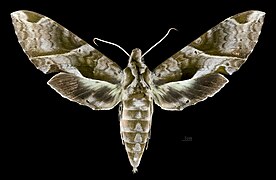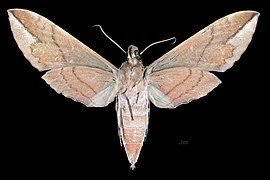
Eumorpha labruscae, the gaudy sphinx, is a moth in the family Sphingidae.

Psilogramma menephron, the privet hawk moth or large brown hawkmoth, is a member of the family Sphingidae. It was described by Pieter Cramer in 1780. It is usually found in Sri Lanka, India, Nepal, central and southern China, Thailand, Vietnam, Indonesia and the Philippines. Psilogramma casuarinae from eastern Australia was long treated as a synonym but is now thought to be a distinct species. The introduced population on Hawaii was first thought to be P. menephron, but is Psilogramma increta.

Callionima nomius, the fan-tailed bark moth, is a moth of the family Sphingidae. The species was first described by Francis Walker in 1856.

Eumorpha capronnieri is a moth of the family Sphingidae first described by Jean Baptiste Boisduval in 1875.

Eumorpha elisa is a moth of the family Sphingidae.

Eumorpha satellitia, the satellite sphinx, is a moth of the family Sphingidae. The family was first described by Carl Linnaeus in 1771. It lives from Brazil and northern Argentina north through Central America, Mexico, and the West Indies to south Texas and southern Arizona.

Eumorpha triangulum is a moth of the family Sphingidae.

Eumorpha typhon, the Typhon sphinx, is a moth of the family Sphingidae. The species was first described by Johann Christoph Friedrich Klug in 1836.

Eumorpha vitis, known as the vine sphinx, is a moth of the family Sphingidae.

Xylophanes anubus is a moth of the family Sphingidae first described by Pieter Cramer in 1777.

Pergesa is a monotypic moth genus in the family Sphingidae first described by Francis Walker in 1856. Its only species, Pergesa acteus, the green pergesa hawkmoth, was described by Pieter Cramer in 1779.

Theretra pallicosta, the white-edged hunter hawkmoth, is a moth of the family Sphingidae described by Francis Walker in 1856. It is found from Sri Lanka and India, east through Nepal, Bangladesh and Myanmar to Hong Kong and Taiwan and south through Thailand, Laos and Vietnam to Peninsular Malaysia and Indonesia.

Xylophanes media is a moth of the family Sphingidae first described by Walter Rothschild and Karl Jordan in 1903.
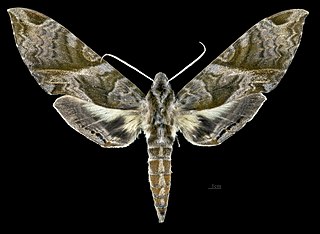
Eumorpha cissi is a moth of the family Sphingidae.
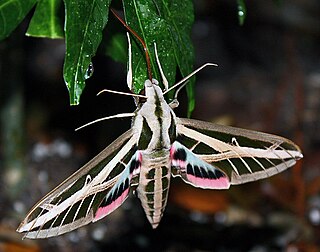
Eumorpha fasciatus, the banded sphinx, is a moth of the family Sphingidae. The species was first described by Johann Heinrich Sulzer in 1776.

Eumorpha obliquus is a moth of the family Sphingidae. It is found from Belize, Guatemala, Nicaragua and Costa Rica south to Bolivia. It is also present in Brazil and Guadeloupe.

Eumorpha translineatus is a moth of the family Sphingidae.
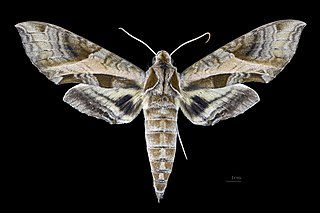
Eumorpha megaeacus is a moth of the family Sphingidae.
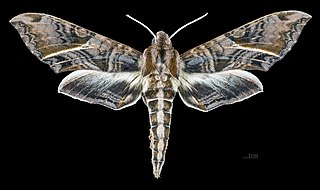
Eumorpha neuburgeri is a moth of the family Sphingidae. It is known from Argentina and Bolivia.

Ambulyx sericeipennis, the common gliding hawkmoth, is a species of moth of the family Sphingidae first described by Arthur Gardiner Butler in 1875. It is found from northern Pakistan and northern India eastwards across Nepal, Sikkim, Bhutan, Myanmar, Thailand, Laos, Cambodia and Vietnam to central and southern China and Taiwan.

